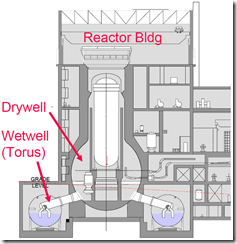The situation surrounding the Fukushima Nuclear Accident, triggered by Japan’s largest recorded earthquake and the resulting 10 m high tsunami, continues to develop rapidly. This post is intended to be a concise update of the situation as of 12pm Japan Standard Time, 15 March 2001. For a summary of the situation prior to today, read these posts:
Japanese nuclear reactors and the 11 March 2011 earthquake
Fukushima Nuclear Accident – a simple and accurate explanation (with further updates at MIT here: http://mitnse.com/)
Japan Nuclear Situation – 14 March updates
Further technical information on Fukushima reactors
TEPCO reactor by reactor status report at Fukushima
This is also a useful summary, from William Tucker (published in the Wall Street Journal): Japan Does Not Face Another Chernobyl. See also: Nuclear Overreactions:Modern life requires learning from disasters, not fleeing all risk.
———————————
Attention has centred on units #1, 2 and 3 of the Fukushima Daiichi plant (all Boiling Water Reactors built in the 1970s). Current concern is focused on unit #2 (more below). Units 4, 5 and 6 at the site were not in service at the time of the earthquake and their situation is stable.
At a nearby plant, Fukushima Daiini, the situation is now under control, and units are in, or approaching, cold shutdown. I do not expect any further significant developments at that site. To quote WNN:
In the last 48 hours, Tepco (Tokyo Electric Power Company) has carried out repairs to the emergency core coolant systems of units 1, 2 and 4 and one by one these have come back into action. Unit 1 announced cold shutdown at 1.24 am today and unit 2 followed at 3.52 am. Repairs at unit 4 are now complete and Tepco said that gradual temperature reduction started at 3.42pm. An evacuation zone extends to ten kilometres around the plant, but this is expected to be rescinded when all four units are verified as stable in cold shutdown conditions.
• Fukushima Daini Unit 1 reactor
o As of 1:24AM on March 14, TEPCO commenced the cooling process after the pumping system was restored.
o At 10:15AM on March 14, TEPCO confirmed that the average water temperature held constant below 212 degrees Fahrenheit.
• Fukushima Daini Unit 2 reactor
o At 7:13AM on March 14, TEPCO commenced the cooling process.
o As of 3:52PM on March 14, the cooling function was restored and the core temperature was stabilized below 212 degrees Fahrenheit.
• Fukushima Daini Unit 3 reactor
o As of 12:15PM on March 13, reactor has been cooled down and stabilized.
• Fukushima Daini Unit 4 reactor
o At 3:42PM on March 14, cooling of the reactor commenced, with TEPCO engineers working to achieve cold shutdown.
The rest of this post will focus on the ongoing crisis situation at Fukushim Daiichi. Let me underscore the fact that accurate information is sparse, uncertain and rapidly changing.
During March 12 and 13, there were serious issues with providing sufficient cooling to units 1 and 3 after the tsunami had caused damage to the diesel backup generators and compromised the emergency cooling water supply. This resulted in a decision to use sea water injection to keep the reactors cool — a process that is ongoing. Steam was regularly vented as part of the effort to relieve steam pressure within the reactor vessels, but this also led to an accumulation of hydrogen gas within the secondary buildings that house the reactor units. Possible sources for the hydrogen are discussed here. Unfortunately, this hydrogen could not be vented sufficiently quickly, resulting in chemical explosions (hydrogen-oxygen interactions) within the two reactor housing buildings of both unit 1 and unit 2 during March 12-13.
The roof and part of the side walls of both buildings were severely damaged as a result. After the first hydrogen explosion there is no longer a roof on the building, so there is little chance of any large buildup of hydrogen or further explosions at these units. [In restrospect, the designers (40 years ago) perhaps should have more carefully considered the implications of the decision to vent the pressure suppression torus to the reactor building space]. Although hydrogen recombiners are a standard feature of that design, they unfortunately lost all AC power, and then the batteries were run down. Containment (the robust concrete shell and 18 inch thick steel reactor vessel within it), however, remained intact. This was verified by monitoring levels of radiation surrounding the units — if there had been any containment breach, levels would have jumped.
This is an overview of the current status of units 1 to 3:
• Radiation Levels
o At 9:37AM (JST) on March 14, a radiation level of 3130 micro sievert was recorded at the Fukushima Daiichi Nuclear Power Station.
o At 10:35AM on March 14, a radiation level of 326 micro sievert was recorded at the Fukushima Daiichi Nuclear Power Station.
o Most recently, at 2:30PM on March 15, a radiation level of 231 micro sievert was recorded at Fukushima Daiichi Nuclear Power Station.
• Fukushima Daiichi Unit 1 reactor
o As of 12:00AM on March 15, the injection of seawater continues into the primary containment vessel.
• Fukushima Daiichi Unit 2 reactor
o At 12:00PM on March 14, in response to lower water levels, TEPCO began preparations for injecting seawater into the reactor core.
o At 5:16PM on March 14, the water level in the reactor core covered the top of the fuel rods.
o At 6:20PM on March 14, TEPCO began to inject seawater into the reactor core.
o For a short time around 6:22PM on March 14, the water level inside the reactor core fell below the lower measuring range of the gauge. As a result, TEPCO believes that the fuel rods in the reactor core might have been fully exposed.
o At 7:54PM on March 14, engineers confirmed that the gauge recorded the injection of seawater into the reactor core.
o At 8:37PM on March 14, in order to alleviate the buildup of pressure, slightly radioactive vapor, that posed no health threat, was passed through a filtration system and emitted outside via a ventilation stack from Fukushima Daiichi Unit 2 reactor vessel.
• Fukushima Daiichi Unit 3 reactor
o At 11:01AM on March 14, an explosion occurred at Fukushima Daiichi Unit 3 reactor damaging the roof of the secondary containment building. Caused by the interaction of hydrogen and oxygen vapor, in a fashion to Unit 1 reactor, the explosion did not damage the primary containment vessel or the reactor core.
o As of 12:38AM (JST) on March 15, the injection of seawater has been suspended.
What is of most current concern?
Units 1 and 3: the situation now seems fairly stable. There is some concern that holding pools for spent nuclear fuel (SNF) may have been damaged by the hydrogen explosions, but nothing is confirmed. Provided the pool walls remain unbreached and the SNF is covered with water, the situation should not escalate. Note: Although still ‘hot’, the SNF decay heat is many orders of magnitude lower than the fuel assemblies within reactors 1 to 3.
Unit 4: A fire has started at the building of Unit #4. Note that the reactor of this unit is stable and was not operating at the time of the earthquake.
Unit 2: This is now of most concern, and the situation continues to change quickly. Here is the key information to hand (I will update as new data emerges).
Loss of Coolant
Serious damage to the reactor core of Fukushima Daiichi 2 seems likely after coolant was apparently lost for a period. Seawater is again being injected, but coolant level is unknown. A spokesman for Tokyo Electric Power Company has appeard on national broadcaster NHK to explain the company’s efforts to control unit 2′s reactor core after its isolation cooling system failed following an increase in containment pressure to some 700 kPa.
Having shut down on 12 March, the amount of decay heat produced by nuclear fuel in the reactor core will have dropped exponentially to less than a few percent of its value on shutdown, but this still must be removed by the passage of water. The company prepared to inject seawater into the reactor system, but this was only started “after the water level reached the top of the fuel.” Gauges indicated that water levels continued to drop despite the injection process and after some time injection became impossible due to high pressure. closeing the relief valve made injection possible again, but after a time pressure relief was again required. Injection has continued since that second venting operation but gauges still do not indicate that water levels are rising.
Developing situation
Loud noises were heard at Fukushima Daiichi 2 at 6.10am this morning. A major component beneath the reactor is confirmed to be damaged. A fire is burning at unit 4 and evacuation to 30 kilometres is being urged. Confirmation of loud sounds at unit 2 this morning came from the Nuclear and Industrial Safety Agency (NISA). It noted that “the suppression chamber may be damaged.” It is not clear that the sounds were explosions.
The pressure in the pool was seen to decrease from three atmospheres to one atmosphere after the noise, suggesting possible damage. Radiation levels on the edge of the plant compound briefly spiked at 8217 microsieverts per hour but later fell to about a third that. A close watch is being kept on the radiation levels to ascertain the status of containment. As a precaution Tokyo Electric Power Company has evacuated all non-essential personnel from the unit.
The company’s engineers continue to pump seawater into the reactor pressure vessel in an effort to cool it. Prime minister Naoto Kan has requested that everyone withdraw from a 30 kilometer evacuation zone around the nuclear power plant and that people that stay within remain indoors. He said his advice related to the overall picture of safety developments at Fukushima Daiichi, rather than those at any individual reactor unit.
Regarding radiation levels: It is very important to distinguish between doses from the venting of noble-gas fission products, which rapidly dissipate and cause no long-term contamination or ingestion hazard, and aerosols of other fission products including cesium and iodine.
An explosion in the vicinity of the suppression pool at Fukushima Daiichi 2 just after 6:20 a.m. Japan Standard Time (5:20 p.m. EDT) may have damaged a portion of the reactor’s primary containment structure. Pressure in the suppression pool has been reported to have decreased to ambient atmospheric pressure shortly after the blast. Plant operator Tokyo Electric Power Co. (TEPCO) has reported possible damage to the reactor’s pressure-suppression system. Radiation levels at local monitoring stations have risen but are still in flux. TEPCO has evacuated some workers from all three Fukushima reactors with the exception of approximately 50 workers involved in sea water pumping activities into the reactors as part of emergency cooling efforts.
More updates to the above as the fog of uncertainty begins to clear…
———————————
Finally, a telling comment from a friend of mine in the US nuclear research community:
The lesson so far: Japan suffered an earthquake and tsunami of unprecedented proportion that has caused unbelievable damage to every part of their infrastructure, and death of very large numbers of people. The media have chosen to report the damage to a nuclear plant which was, and still is, unlikely to harm anyone. We won’t know for sure, of course, until the last measure to assure cooling is put in place, but that’s the likely outcome. You’d never know it from the parade of interested anti-nuclear activists identified as “nuclear experts” on TV.
From the early morning Saturday nuclear activists were on TV labelling this ‘the third worst nuclear accident ever’. This was no accident, this was damage caused by truly one of the worst of earthquakes and tsunamis ever. (The reported sweeping away of four entire trains, including a bullet train which apparently disappeared without a trace, was not labelled “the third worst train accident ever.”) An example of the reporting: A fellow from one of the universities, and I didn’t note which one, obviously an engineer and a knowlegable one, was asked a question and began to explain quite sensibly what was likely. He was cut off after about a minute, maybe less, and an anti-nuke, very glib, and very poorly informed, was brought on. With ponderous solemnity, he then made one outrageous and incorrect statement after another. He was so good at it they held him over for another segment
The second lesson is to the engineers: We all know that the water reactor has one principal characteristic when it shuts down that has to be looked after. It must have water to flow around the fuel rods and be able to inject it into the reactor if some is lost by a sticking relief valve or from any other cause – for this, it must have backup power to power the pumps and injection systems.
The designers apparently could not imagine a tsunami of these proportions and the backup power — remember, the plants themselves produce power, power is brought in by multiple outside power lines, there are banks of diesels to produce backup power, and finally, banks of batteries to back that up, all were disabled. There’s still a lot the operators can do, did and are doing. But reactors were damaged and may not have needed to be even by this unthinkable earthquake if they had designed the backup power systems to be impregnable, not an impossible thing for an engineer to do. So we have damage that probably could have been avoided, and reporting of almost stunning inaccuracy and ignorance.Still, the odds are that no one will be hurt from radioactivity — a few workers from falling or in the hydrogen explosions, but tiny on the scale of the damage and killing around it.
It seems pathetic that Russia should be the only reported adult in this – they’re quoted as saying “Of course our nuclear program is not going to be affected by an earthquake in Japan.” Japan has earthquakes. But perhaps it will be, if the noise is loud enough.





评论一下?